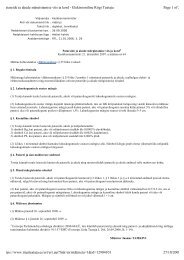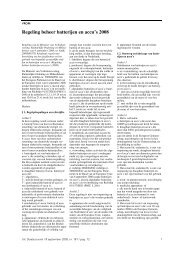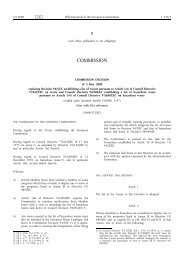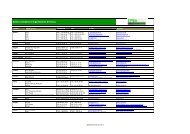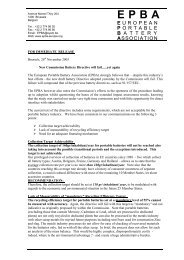New White Swan Criteria for Rechargeables - European Portable ...
New White Swan Criteria for Rechargeables - European Portable ...
New White Swan Criteria for Rechargeables - European Portable ...
Create successful ePaper yourself
Turn your PDF publications into a flip-book with our unique Google optimized e-Paper software.
ContentWhat is a Nordic Ecolabelled rechargeable battery? 3Why choose the Nordic Ecolabel? 3What products are eligible <strong>for</strong> a Nordic Ecolabel? 4How to apply 4What are the requirements <strong>for</strong> a Nordic Ecolabel to be awarded? 61 Environmental requirements 62 Packaging and in<strong>for</strong>mation 83 Working conditions 94 Efficiency/quality 95 Quality requirements and the requirements of the authorities 12Analysis laboratory/test institution 14Marketing 14The design of the Nordic Ecolabel 14Follow-up inspections 15How long will the licence remain in <strong>for</strong>ce? 15<strong>New</strong> criteria 15Appendix 1 The marketing of Nordic ecolabelled rechargeable batteriesAppendix 2 Declaration on packaging by the applicantAppendix 3 Declaration by the producer of the battery chargerAppendix 4 Declaration on nanotechnology by the applicantAppendix 5 Declaration by the applicant confirming compliance with laws and regulationsRechargeable batteries 030, version 4.0, 7 December 2010This document is a translation of an original in danish. In case of dispute, the original document should betaken as authoritative.AddressesIn 1989, the Nordic Council of Ministers decided to introduce a voluntary official ecolabel, the <strong>Swan</strong>.These organisations/companies operate the Nordic ecolabelling system on behalf of their own country’sgovernment. For more in<strong>for</strong>mation, see the websites.DenmarkEcolabelling DenmarkDanish Standards FoundationKollegievej 6DK-2920 CharlottenlundPhone +45 72 300 450Fax +45 72 300 451E-mail: info@ecolabel.dkwww.ecolabel.dkSwedenEcolabelling SwedenSE-118 80 StockholmPhone +46 8 55 55 24 00Fax +46 8 55 55 24 01E-mail: svanen@ecolabel.sewww.ecolabel.seNorwayEcolabelling NorwayTordenskiolds gate 6 BNO-0160 OsloPhone +47 24 14 46 00Fax +47 24 14 46 01E-mail: info@ecolabel.nowww.ecolabel.noFinlandEcolabelling FinlandBox 489FIN-00101 HelsinkiPhone +358 424 2811Fax +358 424 281 299E-mail: joutsen@motiva.fiwww.ecolabel.fiIcelandEcolabelling IcelandUmhverfisstofnunSuðurlandsbraut 24IS-108 ReykjavikPhone +354 591 20 00Fax +354 591 20 20E-mail: svanurinn@ust.iswww.svanurinn.isThis document may only be copied in its entirety andwithout any kind of alteration. It may be quoted fromprovided that Nordic Ecolabelling is stated as the source.
What products are eligible <strong>for</strong> a NordicEcolabel?Under these criteria a licence may be applied <strong>for</strong> <strong>for</strong> the following products: portablebatteries that are rechargeable in accordance with the definition provided inthe <strong>European</strong> Union’s Batteries Directive 2006/66/EC of September 2006.According to the <strong>European</strong> Union’s Batteries Directive 2006/66/EC of 6September 2006, a rechargeable battery is: Any source of electrical energygenerated by direct conversion of chemical energy and consisting of one ormore secondary battery cells (rechargeable).<strong>Portable</strong> batteries are confined to: Any battery or button cell, or any batterypack or accumulator, that is sealed, can be hand-carried and is neither anindustrial battery or accumulator nor an automotive battery or accumulator.The criteria do not encompass primary (non-rechargeable) batteries, <strong>for</strong> whichseparate criteria exist.The criteria do not encompass batteries that are built into or <strong>for</strong>m a permanentpart of electronic products and where replacement of the batteries is not possible.Nordic Ecolabel licences are not available <strong>for</strong> chargers <strong>for</strong> rechargeable batteriesalone. Batteries sold in combination packs with a charger are eligible <strong>for</strong> a NordicEcolabel (including where batteries are sold together with, <strong>for</strong> example, powertools where the charger is purchased together with the tool and battery or Nordicecolabelled batteries designed <strong>for</strong> particular applications where the battery is soldtogether with a charger as part of the electrical appliance). If so, the charger mustfulfil the requirements of R5, R6 and R13. The entire combination pack mustfulfil the packaging requirements (R7, R8 and R9). It must be made clear to thepurchaser of combination packs of this type that the Nordic Ecolabel applies tothe batteries and not to the charger or to other elements of the package.How to applyEach requirement is mandatory and is labelled with a capital R and a number.In order <strong>for</strong> a licence to be awarded, all requirements must be fulfilled.The requirements can also be used as a check list, with each requirement beingfollowed by check boxes, Yes and No, indicating whether the requirementshave been fulfilled.Icons used in the textEach requirement is accompanied by a description of the way in which therequirement must be documented. Various icons are also used in order tomake this work easier. These icons are:( EncloseThe requirement will be checked at the production siteIf the requirement needs an explanation (e.g. footnotes), this will follow in italicsdirectly after the requirement (explanatory text).Nordic Ecolabelling of Rechargeable batteries 4.0 4 (15)
R10Consumer in<strong>for</strong>mation on the batteryThe batteries must carry a clear indication of their capacity in accordancewith the requirements applicable to capacity labelling provided <strong>for</strong> in theEU’s Batteries Directive 2006/66/EC.”Clear indication” means that the capacity labelling shall be expressed in terms of a unit(mAh) and that other numerical markings on the battery must not be such that the customeris likely to be mislead into thinking that they represent the capacity labelling.( A sample of the in<strong>for</strong>mation provided on the battery.YesNoAppendix no. _____3 Working conditionsR11Working conditionsThe licenceholder must have a code of conduct in place in accordance withthe ten principles provided <strong>for</strong> in the United Nations Global Compact.The licenceholder must ensure that the code of conduct is communicated toall suppliers/subcontractors together with a request that these should alsocomply with a code of conduct that follows the ten principles provided <strong>for</strong>in the United Nations Global Compact.NB: The principles embodied in the United Nations Global Compact include the following:human rights, employee rights, environmental protection and anti-corruption safeguards.Further in<strong>for</strong>mation can be found at http://www.unglobalcompact.org.If nanoparticles are used in the batteries, safeguards must be in placeto ensure that employees are not exposed to the nanoparticles duringproduction of the batteries and during internal refuse processing of thenanoparticles and batteries.( Copy of the licenceholder’s ”Code of Conduct”.Description of the way in which subcontractors and producers are notifiedof the licenceholder’s code of conduct and of the licenceholder’s requestthat they have a code of conduct in place that follows the ten principles inthe United Nations Global Compact.( If nanoparticles are used in the batteries: Description of measures put inplace to ensure that employees are not exposed to the nanoparticles.Description of the way in which waste and residues of nanoparticles aresorted and processed.Are the requirementsmet?YesNoAppendix no. _____Appendix no. _____4 Efficiency/qualityR12The quality of rechargeable batteriesQuality testing must be per<strong>for</strong>med by an impartial test laboratory whichfulfils the general requirements applicable to test institutions provided <strong>for</strong> inthe chapter headed ”Analysis laboratory/test institution”Two tests must be per<strong>for</strong>med: Initial capacity testing and cycle life testing.Initial capacity testing is per<strong>for</strong>med in order to ensure that the capacity ofthe cells/batteries corresponds to the actual discharge ability of fresh cells/batteries. Cycle life testing is per<strong>for</strong>med in order to ensure that the cells/batteries have an appropriate number of charge/discharge cycles offeringan acceptable level of per<strong>for</strong>mance.Are the requirementsmet?YesNoNordic Ecolabelling of Rechargeable batteries 4.0 9 (15)
Each test must include at least four batteries of each size and brand model.C is the nominal capacity of the battery and is stated on the battery asmAh. The highest capacity value specified on the cell must be used <strong>for</strong> thepurposes of testing.The test starts by discharging the battery to its final voltage C/5 current(residual discharge capacity).Start capacity testing:All batteries that undergo testing must meet the following requirements:l At least one of the 5 cycles per<strong>for</strong>med in the test must involve a dischargeperiod of a minimum of 5 hours.Capacity testing must be per<strong>for</strong>med in accordance with Table 1 below.The rest period between charging/discharging and discharging/charging isdefined as one hour.Table 1Cycle No. Charging Discharging1-5 In accordance with the recommendationsof the manufacturer0.2C cut-off voltage 11Cut-off voltage will vary depending on the chemical composition of the battery in question.A typical cut-off voltage <strong>for</strong> conventional Li-ion/LiP cells is 3V/cell and 1V/cell <strong>for</strong> NiMH.Nickel-metal hydride (NiMH) batteries and cells:The conditions during capacity testing must be in accordance with the, atthe time of application applicable, IEC 61951-2 standard <strong>for</strong> NiMH cellsand batteries.Li-ion/LiP batteries and cells:The conditions during capacity testing must be in accordance with the, atthe time of application applicable, IEC 61960 standard <strong>for</strong> Li-ion/LiP cellsand batteries applicable at the time of application.Batteries and cells other than Li-ion/LiP or NiMH batteries and cells:The conditions during capacity testing must be in accordance with the relevantstandard <strong>for</strong> the type of battery in question. The independent test laboratoryper<strong>for</strong>ming the test must per<strong>for</strong>m a written assessment to determine whichstandard is relevant <strong>for</strong> the type of battery in question.Cycle life testing:All tested batteries must meet the following requirements:l The discharge time <strong>for</strong> cycle 799 must be at least 30 minutes (correspondto 50% of remaining capacity)l The discharge time <strong>for</strong> cycle 800 must be at least 3.5 timer hours(correspond to 70% of remaining capacity)Table 2 provides test specificationsNordic Ecolabelling of Rechargeable batteries 4.0 10 (15)
The measurement must produce the following results:l The charger must automatically stop charging when the battery is fullycharged. Fully charged is defined as a reference charge with a cut-off of- ΔV = 5 mV ± 10%.l The maximum trickle charge current must on average be ≤ C/20, basedon the lowest battery capacity that the charger is recommended to chargeby the dealer.l The maximum no-load current must on average be < C/50, based onthe lowest battery capacity that the dealer recommends the charger isrecommended to charge.( Results of test as described in the requirement, per<strong>for</strong>med by an impartialtest institution.( Declaration confirming that the test institution is impartial and fulfils thegeneral requirements applicable to the test institutions provided <strong>for</strong> in thechapter “Analysis laboratory/test institution” below.Appendix no. _____Appendix no. _____5 Quality requirements and the requirements ofthe authoritiesAre the requirementsmet?The following procedures must be in place in order to ensure that the NordicEcolabel requirements are fulfilled.If the battery manufacturer has an environmental management system certifiedin accordance with ISO 14 001 or EMAS incorporating the following procedures,it will be sufficient <strong>for</strong> the accredited auditor to confirm that the requirementshave been implemented.R14Responsibility <strong>for</strong> the Nordic EcolabelOne person at the licenceholder and at the producer if the latter is not thesame as the <strong>for</strong>mer must be allocated responsibility <strong>for</strong> fulfilment of the NordicEcolabel requirements and one person must be allocated responsibility <strong>for</strong>contact with Nordic Ecolabelling.( Organogram showing the persons responsible <strong>for</strong> the above duties.YesNoAppendix no. _____R15DocumentationThe licenceholder must be able to present a copy of the application andthe basis <strong>for</strong> calculations and data (including test reports, documents fromsubcontractors and the like) underlying the documentation submitted inconnection with the application.YesNoOn-site inspection.R16The quality of the rechargeable batteriesThe licenceholder must guarantee that the quality of the Nordic Ecolabelledrechargeable batteries will not decline while the licence remains in <strong>for</strong>ce.( Procedures <strong>for</strong> registering and where necessary handling complaints concerningthe quality of the Nordic Ecolabelled rechargeable batteries.YesNoAppendix no. _____Nordic Ecolabelling of Rechargeable batteries 4.0 12 (15)
R17Planned changesPlanned changes which impact on the Nordic Ecolabel requirements mustbe reported in writing to Nordic Ecolabelling.( Procedures showing how planned changes are handled.YesNoAppendix no. _____R18Un<strong>for</strong>eseen deviationsUn<strong>for</strong>eseen deviations which impact on the Nordic Ecolabel requirementsmust be reported in writing to Nordic Ecolabelling and logged in a journal.( Procedures showing how un<strong>for</strong>eseen deviations are handled.YesNoAppendix no. _____R19TraceabilityThe licenceholder must be able to trace the Nordic Ecolabelled rechargeablebattery in the production process.( Description/procedures <strong>for</strong> how this requirement is fulfilled.YesNoAppendix no. _____R20Laws and RegulationsThe licenceholder must ensure that the applicable regulations governingsafety, working environment, environmental legislation and plant-specificterms/permits are followed at all production sites at which the NordicEcolabelled products are produced.( Documentation in which the licenceholder confirms fulfilment of therequirement and reporting to the regulatory authority. Appendix 5 mustbe completed and submitted to Nordic Ecolabelling.YesNoAppendix no. _____R21MarketingNordic Ecolabelled rechargeable batteries must be marketed in accordancewith “Rules on Nordic Ecolabelling” of 12 December 1011 or later versions.If the Nordic Ecolabelled rechargeable batteries are sold together with acharger, it must be made clear to the consumer, <strong>for</strong> example by means of thepositioning of the Nordic Ecolabel logo and the text on the packaging, thatthe Nordic Ecolabel applies to the batteries only and not to the charger.( Duly completed Appendix 1.( If the Nordic Ecolabelled batteries are sold together with a charger, a sampleof the packaging must be submitted, clearly showing that the Nordic Ecolabelapplies to the batteries only and not to the charger.Yes NoAppendix no. _____Appendix no. _____Nordic Ecolabelling of Rechargeable batteries 4.0 13 (15)
Analysis laboratory/test institutionThe analysis laboratory/test institution must be impartial and competent. Theanalysis laboratory/test institution must fulfil the general requirements provided<strong>for</strong> in the EN 45001/DS//EN/ISO/IEC 17025 standard or be an officialGLP-approved analysis laboratory.MarketingThe Nordic Ecolabel is a trademark that is familiar and respected in theNordic countries. The Nordic Ecolabelled product may be marketed using theNordic Ecolabel <strong>for</strong> as long as the licence remains in <strong>for</strong>ce.The Nordic Ecolabel must be positioned in such a way that no doubt existsabout the meaning of the labelling and in such a way that it is made clear thatthe rechargeable batteries are ecolabelled.Further in<strong>for</strong>mation on marketing can be found in ”Rules on NordicEcolabelling” of 12 December 2001 or subsequent versions.The design of the Nordic EcolabelThe design of the Nordic Ecolabel is as follows:Licence NumberFurther in<strong>for</strong>mation on the design of the label can be found in ”Rules onEcolabelling” of 12 December 2001 or subsequent versions.Nordic Ecolabelling of Rechargeable batteries 4.0 14 (15)
Follow-up inspectionsNordic Ecolabelling may check to ensure that the rechargeable batteries continueto fulfil the Nordic Ecolabel requirements after a licence has been granted. Thismay take the <strong>for</strong>m of, <strong>for</strong> example, on-site inspections or random sampling.If this process reveals that the rechargeable batteries do not fulfil the requirements,then the licence may be withdrawn.Random samples can also be taken at points of sale and analysed by an impartiallaboratory. If the requirements are not fulfilled, Nordic Ecolabelling may requirethe licenceholder to pay the costs of analysis.How long will the licence remain in <strong>for</strong>ce?Nordic Ecolabelling adopted the criteria <strong>for</strong> version 4 of the NordicEcolabelling of rechargeable batteries on December 7th 2010. These criteriaremain valid until December 31st 2013.The licence will apply <strong>for</strong> as long as the criteria continue to be fulfilled and <strong>for</strong>as long as the criteria remain in <strong>for</strong>ce. The criteria may be extended or amended,in which case the licence will be extended automatically and the licenceholderwill be in<strong>for</strong>med to this effect.One year be<strong>for</strong>e the expiry date of the criteria at the latest, notice will begiven of the criteria that will apply thereafter. The licenceholder will then begiven the opportunity to renew the licence.<strong>New</strong> criteriaThe possibility should be considered of imposing further requirements onconstituent substances, particularly heavy metals and the use of solvents in theproduction of the batteries.The possibility of imposing requirements on energy consumption during theproduction of the batteries should be considered.The possibility of imposing transport requirements on certain types ofrechargeable batteries should be considered.Collection figures in the Nordic countries should be monitored with a view todetermining whether further requirements as to consumer in<strong>for</strong>mation shouldbe imposed.The possibility of imposing the requirement that further consumer in<strong>for</strong>mationon optimum use/charging of rechargeable batteries should be considered.Nordic Ecolabelling of Rechargeable batteries 4.0 15 (15)
Appendix 1 The marketing of Nordic ecolabelledrechargeable batteriesWe hereby certify that we are familiar with the rules governing the use ofthe Nordic Ecolabel, as provided <strong>for</strong> in “Rules on Nordic Ecolabelling” of12 December 2001 or subsequent versions, and we undertake to market theNordic Ecolabelled rechargeable batteries in accordance with these rules.We also confirm that we are familiar with the contents of the criteria <strong>for</strong> theNordic Ecolabelling of rechargeable batteries.We hereby undertake to in<strong>for</strong>m the personnel responsible <strong>for</strong> marketing theNordic Ecolabelled rechargeable batteries at our company of the criteriagoverning the Nordic Ecolabelling of rechargeable batteries and “Rules onNordic Ecolabelling” of 12 December 2001 or subsequent versions.Place/dateCompanyContact personTelephone No.Person responsible <strong>for</strong> marketingTelephone No.In the event of changes in personnel, new certification must be submitted tothe ecolabelling organisation.Nordic Ecolabelling of Rechargeable batteries 4.0
Appendix 4 Declaration on nanotechnology by the applicantHave nanoparticles been added to the batteryYesNoIf yes:The nanoparticles present in the battery have been added exclusively to theanode in order to increase the energy efficiency of the batteryYesNoThe energy efficiency of the battery has been improved by ______________by means of the use of the nanoparticles in the anode material.Name of company (licence applicant)DatePerson responsibleTelephoneNordic Ecolabelling of Rechargeable batteries 4.0
Appendix 5 Declaration by the applicant confirming compliancewith laws and regulationsI hereby declare that the applicable provisions governing safety, working environment,environmental legislation and plant-specific conditions/permits arefollowed at the production site <strong>for</strong> the Nordic ecolabelled rechargeable battery.The following authorities are responsible <strong>for</strong> supervising the production site.The working environment (name, address, telephone number):_______________________________________________________________________________________________________________________________________________________________________________________Environmental legislation (name, address, telephone number)_______________________________________________________________________________________________________________________________________________________________________________________Plant-specific conditions/permits (name, address, telephone number):_______________________________________________________________________________________________________________________________________________________________________________________Name of business (licence applicant)DatePerson responsibleTelephoneNordic Ecolabelling of Rechargeable batteries 4.0



